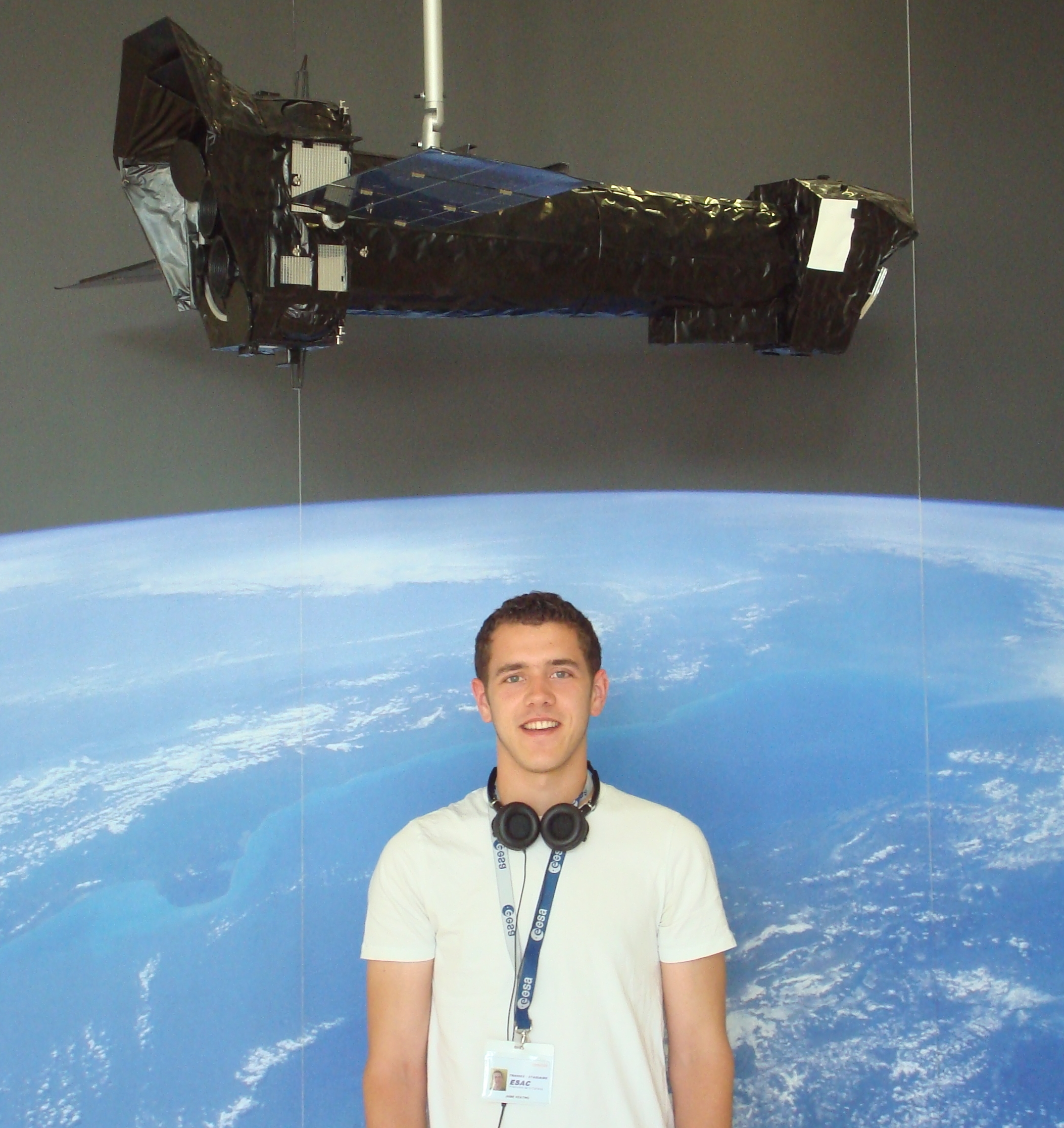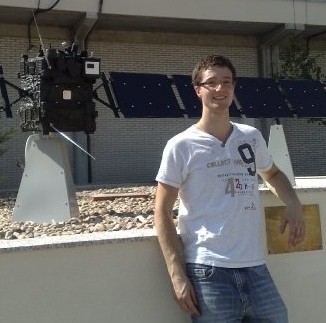Trainees 2009 - ESAC Trainees
 The 2009 Project |
Trainees
|
Simplified access to INTEGRAL Data (SAID)
Tutors. Marion Cadolle Bel & Silvia de Castro The INTEGRAL Science Operations Centre (ISOC) provides a number of services to the gamma-ray community. Among these are the INTEGRAL Observation Schedule Application (IOSA) and the ISOC Science Data Archive (ISDA). This project aims at integrating the IOSA and ISDA such that the IOSA can be used to download data from INTEGRAL observations and to launch the tools for visualizing INTEGRAL data. The aim is not to reproduce the powerful functionality of the ISDA, but to provide a greatly simplified view of the INTEGRAL data in an environment which is already familiar to the majority of the gamma-ray community. Users of the IOSA should have the option of launching the full ISDA browser at any stage. By this, we will not only increase the accessibility of INTEGRAL but also increase the awareness of the ISDA. The ISDA also includes a VIRTUAL Observatory interface which will be used to communicate between the two packages.
|
 |
Irene Cerro Universidad Politècnica de Madrid |
|
Jorge Lillo Box
Universidad de La Laguna
|
Reddening determination from ultraviolet spectra Tutor. Carmen Morales In terms of spectroscopy, the UV range of the spectrum doesn't seem to be very observed. Satellites TD1 and IUE were the first ones that work in that way. However, IUE finished its work in 1996 and from then to the current day, no satellites have been launched to do UV spectroscopy. Thus, what we want to show in that work is the importance of having precise instruments in satellites working in the ultraviolet spectrum range. With this proposal, we are determining, only with the UV spectra, the effective temperature of a sample of B-type stars near the Sun. We are going to do this by using VOSA (a Virtual Observatory tool to analyze SEDs). This tool fits the best Kurucz model according to the observations and gives you the effective temperture, gravity and metallicity of this fitted model. In that way, as the dependence on the physical parametres of a B star is stronger in the UV range, we want to show that if you fit the model only using this range, the results are better than using visible and/or the infrared range.
However, this is not the only advantage of using the UV range instead of visible and infrared ranges. We have developed a new method to determine the color excess using only the UV spectra between 1700 A and 2400 A. Even if you don't know the spectral type or the physical parametres of the star, this method will give you the E(B-V). |
|
|
Identification of very massive AGB stars at the GLIMPSE survey
Tutors. Francisco Jimenez-Esteban & Enrique Solano
Most massive AGB stars have been systematically avioded from studies because of the low spatial resolution of the first infrared surveys. Our goal is to use the more recent GLIMPSE survey catalogue in combination with other catalogues available to search for new massive AGB star candidates, increasing the number of known sources, and use them for stellar evolutionary studies. We use tools from the Virtual Observatory, taking advance of its capabilities.
|
Ruben Herrero Illana Universidad de La Laguna |
|
|
Jamie Keating
University College Dublin
|
 |
Studying the long term variability of Vela X-1 with the RXTE/ASM Tutor. Peter Kretschmar The aim of this project is to study the average period profile of Vela X-1 on a long time scale. The archetypical wind-accreting X-ray pulsar Vela X-1 is known to be variable on a large range of timescales. Relatively tranquil phases exist as well as extended phases of high variability and flaring. Light curves are readily available on this source. RXTE/ASM has an archive of over 12 years of data and combined with the data obtained from Swift/BAT, an analysis of the orbital profile of the high mass X-ray binary can be studied for features. Results from a systematic study of variations with orbital phase and other timescales can be presented over a variety of energy bands to see how the features vary with energy and why? It appears, from the results obtained, that the absorption of photons by the wind in the system cause features more noticably at lower energies. Whereas, the light curves at higher energy bands show the sort of shape predicted by wind accretion theory.
|
|
Study and Application of Supperresolution Techniques to the Images from the OSIRIS cameras onboard Rosetta
Tutors. Jose Vazquez & Micheal Kueppers Superresolution is a method which overcomes the limits of optical systems by creating a high resolution image through the combination of a set of lower resolution images of the same target. Application of such methods can substantially improve the quality of images taken by interplanetary spacecraft. However, the rapid change of viewing geometry imposes challenges on the application of superresolution techniques in planetary science.
Highlighting the potential of suppersolution algorithms in the image enhancement during the Rosetta's prime mission at Comet 67/Churyumov is particularly interesting. To reach this goal, my work was a preliminary study using the images of Asteroid (2867) Steins taken during Rosetta's flyby in Sept. 2008 from the OSIRIS scientific camera system. I had to find the more suitable method for these images among all the superresolution algorihms which already exist and to begin the implementation. |
 |
Leila Khallefi University of Paris |
|
Luke Maud
University of Leeds
|
 |
Study of disk evolution around young stars and the formation of the exoplanets Tutor. Bruno Merin Here at ESAC I am analysing photometry data from Young Stellar Objects (YSOs). I currently have a sample of 1024 YSOs from the Spitzer c2D (cores to disks) Legacy program (summarized in Evans et. al. 2009) and I am producing Spectral Energy Distribution (SED) plots. In the low mass star formation scenario, including YSOs of ~2 Solar masses and below, there are three classical classifications I,II and III dependent upon observed properties such as sub-millimeter, IR excess and/or outflows and disks. My project focuses on the later classes II and III, which I have to extract from my sample via the SED analysis. Using these particular objects the aim is to attain information about the evolutionary processes in detail, evaluating the different mass and age groups of the YSOs. The ultimate goal is to link the evolution with the possibility of planet formation in particular objects.
|
|
mySpaceCal: when and where does a satellite look?
Tutor. Erik Kuulkers We have a wealth of astronomical satellites circling around the earth staring at numerous astronomical targets. But on a given time, where exactly do they look? Each satellite project has its own devoted time schedule retrievable from the internet. The aim of this project was to combine the time schedules (short term as well as long term) and make the information accessible in one go. The project focused first on satellites observing in a common wavelength, i.e., X-rays, investigating exotic objects in the sky such as black holes: XMM-Newton, Swift, RXTE, Chandra, INTEGRAL, and finding what are the targets of the day, of the week, and of the month.
|
Vicente Albert Rodriguez Universidad de Valencia |
|
|
Cecile Merlet
Paris Observatory & University of Paris
|
Searching for brown dwarfs and planetary mass objects Tutor. David Barrado & Nuria Huelamo Young stellar associations are Rosetta stones which have been instrumental to decipher numerous astronomical problems. We are searching for very low-mass objects, both brown dwarfs and planetary mass objects, in the Head of Orion, a very interesting stellar complex, by using deep optical photometry (Calar Alto+BUSCA, INT+WFC, Subaru+SuprimeCam), near-infrared imaging (Calar Alto+Omega2000, WHT+LIRIS), mid-infrared data (Spitzer and Akari) and X-ray observations (XMM/Newton). All this wealth of data will be used to try to detect the minimum mass at the end of the stellar/substellar Main Sequence, which should be in the range 10-3 M(jupiter). This project involved the reduction and analysis of the deep near-infrared imaging, which will be combined later on with the Spitzer and the optical data in order to study the properties of the substellar candidates.
|
|
|
Hyperspectral and multiangular data fusion for planetary science
Tutors. Frederic Schmidt & Albrecht Schmidt Over the past few decades, studies of planetary surfaces have benefited from three main technical improvements: higher spatial resolution to analyse the details of surface processes; higher spectral resolution (through the development of hyperspectral imaging) to identify the chemical compounds and their physical state; and multiangular measurements (observation of the same scene under different geometric conditions) to unravel or discriminate atmospheric signals from the surface signals. The fusion of those different types of data is a key issue for the future of planetary science, i.e., Terrestrial and Solar System studies. By fusing data from these three imaging improvements, it should be possible to extract scientific features with higher confidence. This project involved using data fusion to estimate the surface signals, the atmospheric alteration and the geometric uncertainties and applying them to Martian surface studies using Mars Express' OMEGA and HRSC products.
|
Mael Guiheneuf Ecole Centrale de Nantes |
|
|
Gerard Fitzpatrick
University College Dublin
|
The ups and downs of AB Dor Tutor. Andy Pollock Most stars spend most of their time quietly getting on with the steady business of nuclear burning and twinkling in the night sky. AB Dor is anything but quiet. It generates wildly varying X-rays, going up and down in a few hours. XMM-Newton has observed it many times to help maintain the instruments aboard the spacecraft but no-one yet knows how the shape of AB Dor's X-ray spectrum changes during its ceaseless activity. This project involved investigating the variability of the X-ray spectrum of AB Dor.
|
|
|
Studying NH variations in Vela X-1
Tutor. Peter Kretschmar Vela X-1 is a well known wind-accreting X-ray pulsar orbiting its supergiant companion in 8.964 days. The source is persistent but quite variable in its emission, demonstrating sometimes very active phases and sometimes rather calm periods. From past observations it is known that the amount of absorbing gas between the source and the Earth is often varying rapidly and strongly. The absorbing material is commonly described as "NH", number of hydrogen atoms per square cm. The aim of this project was to analyze a large set of existing data from the RossiXTE satellite and to determine the variations in NH. These spectra were then compared to models.
|
Pedro Quintana Universidad Complutense de Madrid |
|
|
Jaime Abella Paya
Universidad Complutense de Madrid
|
The North and South Ecliptic Pole fields population Tutors. Nora Loiseau & Richard Saxton The North and South Ecliptic Poles (NEP and SEP respectively) are the most frequently observed regions by most space observatories, during manoeuvres. In particular the XMM-Newton Slew Survey has its best coverage on these two fields. Previous serendipitous surveys in X-rays (ROSAT) and other wavelengths have been used to produce catalogues of the sources in these deep fields, aiming at the best possible knowledge of the variety of near/galactic to distant/extragalactic sources detected. This project involved the analysis of XMM-Newton Slew Survey data, combining the data of superimposed slews, detecting sources and extracting source parameters of the combined data. The second stage of the project involved completing the sources study using available data in radio, optical and FIR wavelengths using the Virtual Observatory tools VOSpec, TOPCAT and Aladin.
|
|
|
Relativistic emission around neutron stars and black holes
Tutors. Marion Cadolle Bel, Maria Diaz & Simone Migliari A low-mass X-ray binary is a system with either a neutron star or black hole accreting matter from a 'sun-like' companion star orbiting around it, via an accretion disk. A number of these systems, mainly those containing black holes, show iron emission lines which are distorted by the relativistic effects of strong gravity near the compact object. The detection and characterization of these relativistic iron lines is crucial for our understanding of the accretion processes that take place under extreme gravity conditions and constitutes currently one of the hottest topics in high-energy astrophysics. The aim of this project was to perform a systematic analysis of all the X-ray data sets available for the binaries containing a neutron star with XMM-Newton, and to compare the results with the lines detected from black hole binaries, to determine the conditions under which such a relativistic line can be formed. These data-sets provide us with a unique opportunity to understand the complex relations between accretion, extreme gravity, type of compact object and line formation.
|
Cherry NG University College London |
|
|
Maria de Juan Ovelar
Universidad Politècnica de Madrid
|
The soft SNR N132D to study the gain of the EPIC-pn camera Tutor. Matteo Guainazzi The goal of this project was to study the quality of the instrumental response (energy reconstruction, effective area, redistribution) of the EPIC-pn camera on board XMM-Newton. For this purpose, a large dataset of observations of the soft supernova remnant N132D were analyzed. This source exhibits a soft thermal X-ray spectrum, rich in emission lines. The project involved definiing the "ultimate model" of N132D, using also high-resolution (RGS) data, analysing the stability of the instrumental response along the mission using a phenomenological characterization of the N132D spectrum of each individual observation, and characterizing the deviations between observations and predictions in terms of instrument response performance.
|
|
|
Evaluation of the XMM-Newton cross-calibration archive
Tutor. Martin Stuhlinger The XMM-Newton calibration team at ESAC selected a large set of observations for calibration purposes, building the ESAC cross-calibration archive, based on an automated data reduction and fitting tool. The cross-calibration archive contains observations of all kinds of X-ray emitting objects: Active galactic nuclei, supernova remnants, neutron stars, galaxy clusters and stars. Using the large number of observations, statistical analysis provides a key to systematic characteristics within the cross-calibration of all instruments on-board XMM-Newton. This project involved investigating the biases of the observation sample within the cross-calibration archive and adding new observation/targets to the archive to reduce these biases.
|
Ana Garcia Universidad Complutense de Madrid |
|
|
Emilio Antonio Alverez
Universidad Complutense de Madrid
|
Long-term variability in Active Galactic Nuclei Tutor. Richard Saxton Many galaxies contain a gigantic Black hole at their centre which is slowly consuming gas and dust from the galaxy and emitting a huge flux of X-ray radiation. These are the so-called Active Galactic Nuclei (AGN). Surprisingly, for such energetic objects, their brightness appears to change very little over the years. This project involved comparing the brightness of AGNs detected by XMM-Newton with that seen in the same objects by the ROSAT satellite 15 years earlier. In this way we can find the true X-ray variability of many thousands of AGN and investigate whether this variability depends upon other properties such as the Radio or optical brightness.
|
- Removed a total of (1) style text-align:center;
- Removed a total of (1) style text-align:left;
- Removed a total of (41) style text-align:right;
- Removed a total of (22) style text-align:justify;
- Removed a total of (48) align=top;
- Removed a total of (4) align=center.
- Removed a total of (2) border attribute.
- Removed a total of (1) cellpadding attribute.
- Removed a total of (1) cellspacing attribute.








































 Sign in
Sign in
 Science & Technology
Science & Technology